The diagrams of the Viet Drum Law of Changes (VDC) are encoded on the Ngoc Lu bronze drum by different ways. However, the most optimal method to understand them is looking and drawing because:
- Nearly anyone can see & draw simple figures such as circles, squares and lines.
- Fast, clear, accurate.
- What needed are the Drum’s image which freely available & accessible on the web, the basics, & minimal knowledge of the trigrams such as name, symbol, meaning, Am Duong
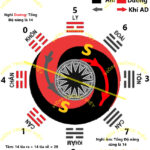 DTV coi quái Càn, Tinh thần, vô hình, vô hạn, vạch liền, số lượng lẻ, vòng tròn & màu đen là âm, còn quái Khôn,... More & energy level
DTV coi quái Càn, Tinh thần, vô hình, vô hạn, vạch liền, số lượng lẻ, vòng tròn & màu đen là âm, còn quái Khôn,... More & energy level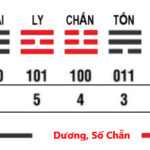 Biểu thị năng lượng của quái bằng số thập phân, thông qua số nhị phân. Represents the energy of the trigram in decimal, through the binary number.... More.
Biểu thị năng lượng của quái bằng số thập phân, thông qua số nhị phân. Represents the energy of the trigram in decimal, through the binary number.... More.
Contents
Deciphering the Drum’s diagrams & laws.
While decoding the Drum, we need to bear in mind the following important points:
Drum is a work of art. For a work of art, the visible is just the tip of what is expressed, evoking something deeper hidden between images.
Drum is also the encoded Viet Drum Law of Changes (VDC). Created as early as 900 BC. At that time, Ha Do Hồng Thư, đồ hình nền tảng của Dịch Trống Việt. Hồng Thư phối với Bát Quái Hồng Thư (BQHT). Hồng thư giống Hà đồ của... More, 8 trigrams, 64 hexagrams were known for hundreds or thousands of years. Therefore, on a circular surface of just 79.3 cm in diameter, it would be a waste of space to depict what is known unless it relates to the esoteric knowledge that the drum wants to encrypt.
Hồng Thư, đồ hình nền tảng của Dịch Trống Việt. Hồng Thư phối với Bát Quái Hồng Thư (BQHT). Hồng thư giống Hà đồ của... More, 8 trigrams, 64 hexagrams were known for hundreds or thousands of years. Therefore, on a circular surface of just 79.3 cm in diameter, it would be a waste of space to depict what is known unless it relates to the esoteric knowledge that the drum wants to encrypt.
Moreover, is also unaesthetic and cannot be called encoding if Drum presents even an entire single diagram if it is an important & not yet known.
The VDC Diagrams’ Names
To correctly express the VDC, we’ll call its diagrams by the following names1Later when you see & know the meaning of the diagrams, you’ll understand why we name them as such:
| Diagrams of the Drum’s Laws | I Ching’s equivalents | |
| 1 | Thai Cuc Viet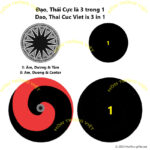 Không ngôn từ nào có thể nói hết về Đạo. Đạo là 3 trong 1. 3 bao gồm Âm, Dương & Tâm. Về thể, Đạo... More (TCV Không ngôn từ nào có thể nói hết về Đạo. Đạo là 3 trong 1. 3 bao gồm Âm, Dương & Tâm. Về thể, Đạo... More (TCV Thái Cực Việt. Viet's Tai Chi. More) or Viet’s Tai Chi. Thái Cực Việt. Viet's Tai Chi. More) or Viet’s Tai Chi. | Tai Chi |
| 2 | Lac do Là một Ma phương cân bằng mọi hướng như Lạc thư của KD nhưng với Dãy số 2, 7, 6 nằm bên trái và phối với... More (LD Là một Ma phương cân bằng mọi hướng như Lạc thư của KD nhưng với Dãy số 2, 7, 6 nằm bên trái và phối với... More (LD Là một Ma phương cân bằng mọi hướng như Lạc thư của KD nhưng với Dãy số 2, 7, 6 nằm bên trái và phối với... More) or Land Directions Là một Ma phương cân bằng mọi hướng như Lạc thư của KD nhưng với Dãy số 2, 7, 6 nằm bên trái và phối với... More) or Land Directions | Lac thu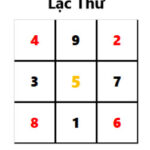 Đồ hình của Kinh Dịch, phối với Hậu Thiên Bát Quái (HTBQ). Lac Thu, a I Ching's Diagram that associates with the Late Heaven Eight... More (LT Đồ hình của Kinh Dịch, phối với Hậu Thiên Bát Quái (HTBQ). Lac Thu, a I Ching's Diagram that associates with the Late Heaven Eight... More (LT Đồ hình của Kinh Dịch, phối với Hậu Thiên Bát Quái (HTBQ). Lac Thu, a I Ching's Diagram that associates with the Late Heaven Eight... More) Đồ hình của Kinh Dịch, phối với Hậu Thiên Bát Quái (HTBQ). Lac Thu, a I Ching's Diagram that associates with the Late Heaven Eight... More) |
| 3 | Bat Quai Lac do Là một Ma phương cân bằng mọi hướng như Lạc thư của KD nhưng với Dãy số 2, 7, 6 nằm bên trái và phối với... More (BQLD Là một Ma phương cân bằng mọi hướng như Lạc thư của KD nhưng với Dãy số 2, 7, 6 nằm bên trái và phối với... More (BQLD Bát Quái Lạc đồ giống TTBQ của KD nhưng phối với số Lạc Đồ còn TTBQ phối Hà Đồ. BQLD is similar to TTBQ or... More): 8 trigrams associate with Lac Do Bát Quái Lạc đồ giống TTBQ của KD nhưng phối với số Lạc Đồ còn TTBQ phối Hà Đồ. BQLD is similar to TTBQ or... More): 8 trigrams associate with Lac Do Là một Ma phương cân bằng mọi hướng như Lạc thư của KD nhưng với Dãy số 2, 7, 6 nằm bên trái và phối với... More Là một Ma phương cân bằng mọi hướng như Lạc thư của KD nhưng với Dãy số 2, 7, 6 nằm bên trái và phối với... More | Early heaven 8 trigrams TTBQ là Bát Quái của Kinh Dịch. TTBQ giống BQLD về vị trí các Quái, tuy nhiên, nó phối với Hà Đồ của KD, còn... More: 8 trigrams partner with Lac thu TTBQ là Bát Quái của Kinh Dịch. TTBQ giống BQLD về vị trí các Quái, tuy nhiên, nó phối với Hà Đồ của KD, còn... More: 8 trigrams partner with Lac thu Đồ hình của Kinh Dịch, phối với Hậu Thiên Bát Quái (HTBQ). Lac Thu, a I Ching's Diagram that associates with the Late Heaven Eight... More Đồ hình của Kinh Dịch, phối với Hậu Thiên Bát Quái (HTBQ). Lac Thu, a I Ching's Diagram that associates with the Late Heaven Eight... More |
| 4 | Hong thu Hồng Thư, đồ hình nền tảng của Dịch Trống Việt. Hồng Thư phối với Bát Quái Hồng Thư (BQHT). Hồng thư giống Hà đồ của... More (HT Hồng Thư, đồ hình nền tảng của Dịch Trống Việt. Hồng Thư phối với Bát Quái Hồng Thư (BQHT). Hồng thư giống Hà đồ của... More (HT Hồng Thư, đồ hình nền tảng của Dịch Trống Việt. Hồng Thư phối với Bát Quái Hồng Thư (BQHT). Hồng thư giống Hà đồ của... More) or Heaven Treatise Hồng Thư, đồ hình nền tảng của Dịch Trống Việt. Hồng Thư phối với Bát Quái Hồng Thư (BQHT). Hồng thư giống Hà đồ của... More) or Heaven Treatise | Ha do Hồng Thư, đồ hình nền tảng của Dịch Trống Việt. Hồng Thư phối với Bát Quái Hồng Thư (BQHT). Hồng thư giống Hà đồ của... More (HD) Hồng Thư, đồ hình nền tảng của Dịch Trống Việt. Hồng Thư phối với Bát Quái Hồng Thư (BQHT). Hồng thư giống Hà đồ của... More (HD) |
| 5 | Bat Quai Hong Thu Hồng Thư, đồ hình nền tảng của Dịch Trống Việt. Hồng Thư phối với Bát Quái Hồng Thư (BQHT). Hồng thư giống Hà đồ của... More (BQHT Hồng Thư, đồ hình nền tảng của Dịch Trống Việt. Hồng Thư phối với Bát Quái Hồng Thư (BQHT). Hồng thư giống Hà đồ của... More (BQHT Bát quái Hồng thư là Bát quái phối với số của Hồng Thư. 8 trigrams related to the numbers of Hong Thu.... More): 8 Trigrams based on the Hong thu Bát quái Hồng thư là Bát quái phối với số của Hồng Thư. 8 trigrams related to the numbers of Hong Thu.... More): 8 Trigrams based on the Hong thu Hồng Thư, đồ hình nền tảng của Dịch Trống Việt. Hồng Thư phối với Bát Quái Hồng Thư (BQHT). Hồng thư giống Hà đồ của... More Hồng Thư, đồ hình nền tảng của Dịch Trống Việt. Hồng Thư phối với Bát Quái Hồng Thư (BQHT). Hồng thư giống Hà đồ của... More | Late heaven 8 trigrams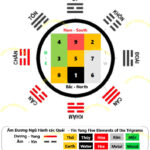 HTBQ là một đồ hình Bát quái của Kinh Dịch. HTBQ phối với Lạc Thư. HTBQ or Late Heaven Eight Trigrams is I Ching's 8... More: 8 trigrams associate with Ha do HTBQ là một đồ hình Bát quái của Kinh Dịch. HTBQ phối với Lạc Thư. HTBQ or Late Heaven Eight Trigrams is I Ching's 8... More: 8 trigrams associate with Ha do Hồng Thư, đồ hình nền tảng của Dịch Trống Việt. Hồng Thư phối với Bát Quái Hồng Thư (BQHT). Hồng thư giống Hà đồ của... More Hồng Thư, đồ hình nền tảng của Dịch Trống Việt. Hồng Thư phối với Bát Quái Hồng Thư (BQHT). Hồng thư giống Hà đồ của... More |
| 6 | 6 Hexagrams of Bat Quai Hong Thu Hồng Thư, đồ hình nền tảng của Dịch Trống Việt. Hồng Thư phối với Bát Quái Hồng Thư (BQHT). Hồng thư giống Hà đồ của... More Hồng Thư, đồ hình nền tảng của Dịch Trống Việt. Hồng Thư phối với Bát Quái Hồng Thư (BQHT). Hồng thư giống Hà đồ của... More | None |
| 7 | Bat Quai Lac Hong (BQLH Bát quái Lạc Hồng (BQLH) hay Tài Nhân (BQTN) là Bát quái hợp nhất của BQLD & BQHT. BQLH cũng đồ hình về con người... More) or Tai Nhan (BQTN Bát quái Lạc Hồng (BQLH) hay Tài Nhân (BQTN) là Bát quái hợp nhất của BQLD & BQHT. BQLH cũng đồ hình về con người... More) or Tai Nhan (BQTN Bát quái Lạc Hồng (BQLH) hay Tài Nhân (BQTN) là Bát quái hợp nhất của BQLD & BQHT. BQLH cũng đồ hình về con người... More): A unified diagram of BQLD Bát quái Lạc Hồng (BQLH) hay Tài Nhân (BQTN) là Bát quái hợp nhất của BQLD & BQHT. BQLH cũng đồ hình về con người... More): A unified diagram of BQLD Bát Quái Lạc đồ giống TTBQ của KD nhưng phối với số Lạc Đồ còn TTBQ phối Hà Đồ. BQLD is similar to TTBQ or... More & BQHT Bát Quái Lạc đồ giống TTBQ của KD nhưng phối với số Lạc Đồ còn TTBQ phối Hà Đồ. BQLD is similar to TTBQ or... More & BQHT Bát quái Hồng thư là Bát quái phối với số của Hồng Thư. 8 trigrams related to the numbers of Hong Thu.... More Bát quái Hồng thư là Bát quái phối với số của Hồng Thư. 8 trigrams related to the numbers of Hong Thu.... More | None |
| 8 | BQLH’s or BQTN’s 64 hexagrams: 64 hexagrams based on BQLH Bát quái Lạc Hồng (BQLH) hay Tài Nhân (BQTN) là Bát quái hợp nhất của BQLD & BQHT. BQLH cũng đồ hình về con người... More or BQTN Bát quái Lạc Hồng (BQLH) hay Tài Nhân (BQTN) là Bát quái hợp nhất của BQLD & BQHT. BQLH cũng đồ hình về con người... More or BQTN Bát quái Lạc Hồng (BQLH) hay Tài Nhân (BQTN) là Bát quái hợp nhất của BQLD & BQHT. BQLH cũng đồ hình về con người... More Bát quái Lạc Hồng (BQLH) hay Tài Nhân (BQTN) là Bát quái hợp nhất của BQLD & BQHT. BQLH cũng đồ hình về con người... More | Late heaven 64 hexagrams |
Hong Thu on the Drum
The drum has 16 concentric circles. We’ll place the drum on the position as shown below & will focus mainly on 4 rings: 1, 6, 8 and 10.
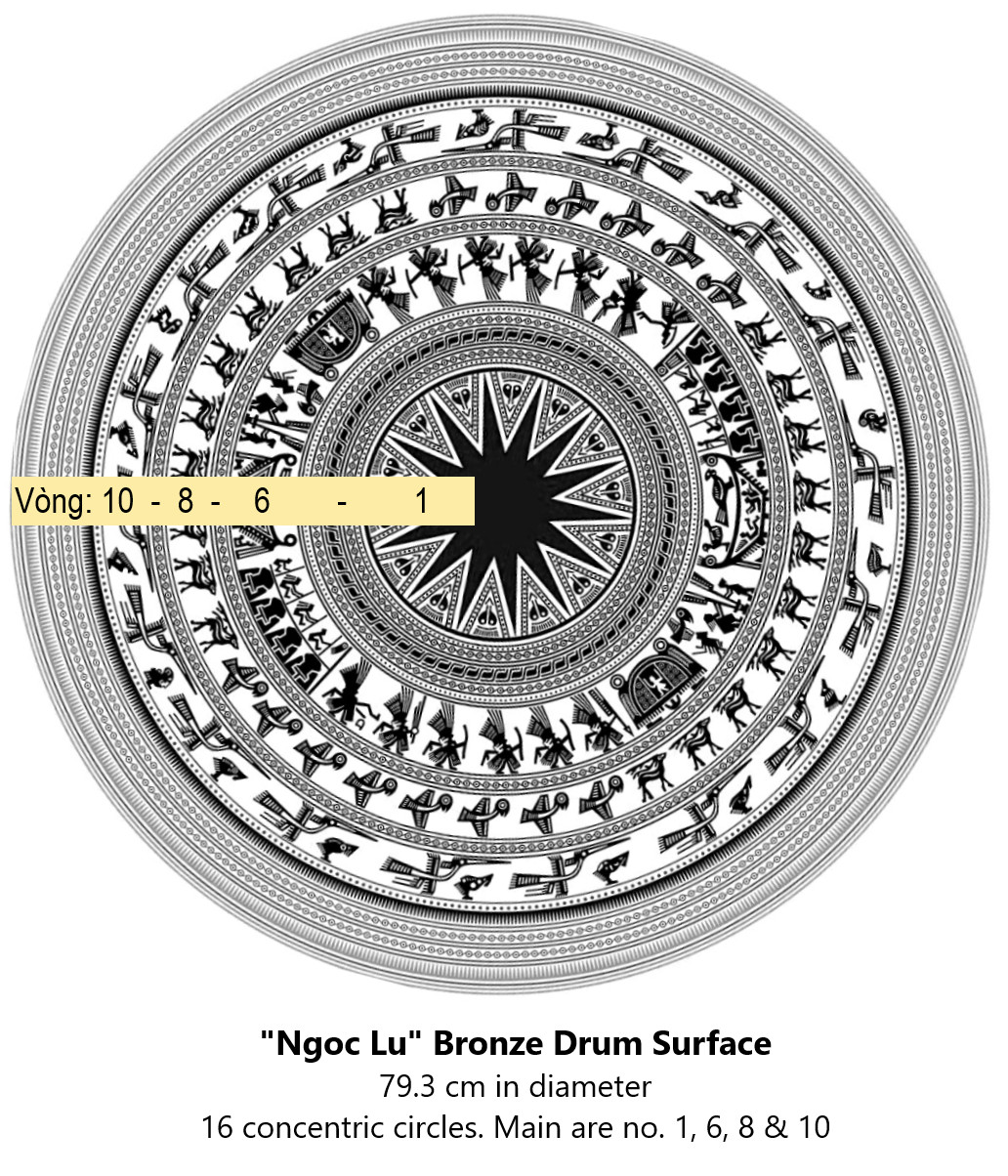
Hong thư, the equivalent to I Ching’s Ha Do Hồng Thư, đồ hình nền tảng của Dịch Trống Việt. Hồng Thư phối với Bát Quái Hồng Thư (BQHT). Hồng thư giống Hà đồ của... More is shown on the ring No. 6.
Hồng Thư, đồ hình nền tảng của Dịch Trống Việt. Hồng Thư phối với Bát Quái Hồng Thư (BQHT). Hồng thư giống Hà đồ của... More is shown on the ring No. 6.


For the 4 pairs at the periphery, Drum uses the quantity of the fingers (blue circled) to indicate the small number of the pair & the quantity of people (red circled), the big number2There are different ways to find out Hong Thu Hồng Thư, đồ hình nền tảng của Dịch Trống Việt. Hồng Thư phối với Bát Quái Hồng Thư (BQHT). Hồng thư giống Hà đồ của... More. However, the above is the simplest & is discovered by the Author Viên Như in the book Người Việt – Chủ nhân của kinh dịch và chữ vuông (Vietnamese, the creators of the I Ching & Square Alphabets or current Chinese alphabets). Nhà xuất bản: Hồng Đức, 2014.
Hồng Thư, đồ hình nền tảng của Dịch Trống Việt. Hồng Thư phối với Bát Quái Hồng Thư (BQHT). Hồng thư giống Hà đồ của... More. However, the above is the simplest & is discovered by the Author Viên Như in the book Người Việt – Chủ nhân của kinh dịch và chữ vuông (Vietnamese, the creators of the I Ching & Square Alphabets or current Chinese alphabets). Nhà xuất bản: Hồng Đức, 2014.
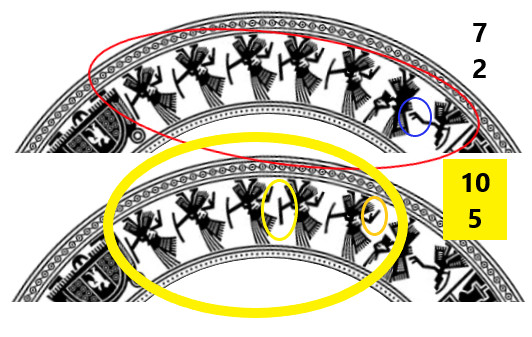
For the 5/10 pair in the center of Hong Thu Hồng Thư, đồ hình nền tảng của Dịch Trống Việt. Hồng Thư phối với Bát Quái Hồng Thư (BQHT). Hồng thư giống Hà đồ của... More, the method of expression is opposite: the quantity of people represents the small number and the quantity of fingers, big number. Besides, the place where Drum shows the pair 5/10 is at the top of the drum, where we also found the 2/7 pair.
Hồng Thư, đồ hình nền tảng của Dịch Trống Việt. Hồng Thư phối với Bát Quái Hồng Thư (BQHT). Hồng thư giống Hà đồ của... More, the method of expression is opposite: the quantity of people represents the small number and the quantity of fingers, big number. Besides, the place where Drum shows the pair 5/10 is at the top of the drum, where we also found the 2/7 pair.
There are 7 people but only 5 holding swords pointing upwards to the Drum’s center. This image represents number 5. Each of 5 persons has 2 fingers pointing down representing the number 10 = 5*2.

The above way to find a pair of 5/10 numbers is good to use as its use of the number of people & fingers is consistent with the method to find other pairs. However, there are other ways, such as using the numbers in Ring 1 as shown on the Figure 5.
The pairs of numbers just found on the drum match the current I Ching’s Ha do Hồng Thư, đồ hình nền tảng của Dịch Trống Việt. Hồng Thư phối với Bát Quái Hồng Thư (BQHT). Hồng thư giống Hà đồ của... More.
Hồng Thư, đồ hình nền tảng của Dịch Trống Việt. Hồng Thư phối với Bát Quái Hồng Thư (BQHT). Hồng thư giống Hà đồ của... More.
As said, Hong Thu Hồng Thư, đồ hình nền tảng của Dịch Trống Việt. Hồng Thư phối với Bát Quái Hồng Thư (BQHT). Hồng thư giống Hà đồ của... More or Ha Do
Hồng Thư, đồ hình nền tảng của Dịch Trống Việt. Hồng Thư phối với Bát Quái Hồng Thư (BQHT). Hồng thư giống Hà đồ của... More or Ha Do Hồng Thư, đồ hình nền tảng của Dịch Trống Việt. Hồng Thư phối với Bát Quái Hồng Thư (BQHT). Hồng thư giống Hà đồ của... More is the fundamental diagram & was well known for hundreds or thousands of years before the Drum’s creation. Therefore, having a complete Hong Thu
Hồng Thư, đồ hình nền tảng của Dịch Trống Việt. Hồng Thư phối với Bát Quái Hồng Thư (BQHT). Hồng thư giống Hà đồ của... More is the fundamental diagram & was well known for hundreds or thousands of years before the Drum’s creation. Therefore, having a complete Hong Thu Hồng Thư, đồ hình nền tảng của Dịch Trống Việt. Hồng Thư phối với Bát Quái Hồng Thư (BQHT). Hồng thư giống Hà đồ của... More or Ha Do
Hồng Thư, đồ hình nền tảng của Dịch Trống Việt. Hồng Thư phối với Bát Quái Hồng Thư (BQHT). Hồng thư giống Hà đồ của... More or Ha Do Hồng Thư, đồ hình nền tảng của Dịch Trống Việt. Hồng Thư phối với Bát Quái Hồng Thư (BQHT). Hồng thư giống Hà đồ của... More displaying on the Drum is ideal but not absolute requirement. In fact, if the Drum depicted just 1-6, 2-7 & 8 or 9, that would be enough to deduce the remaining numbers & pairs.
Hồng Thư, đồ hình nền tảng của Dịch Trống Việt. Hồng Thư phối với Bát Quái Hồng Thư (BQHT). Hồng thư giống Hà đồ của... More displaying on the Drum is ideal but not absolute requirement. In fact, if the Drum depicted just 1-6, 2-7 & 8 or 9, that would be enough to deduce the remaining numbers & pairs.
Bat Quai Lac Do
First of all, let’s review the Yin & Yang & Bagua’s Energy level Biểu thị năng lượng của quái bằng số thập phân, thông qua số nhị phân. Represents the energy of the trigram in decimal, through the binary number.... More shown on Fig. 6.
Biểu thị năng lượng của quái bằng số thập phân, thông qua số nhị phân. Represents the energy of the trigram in decimal, through the binary number.... More shown on Fig. 6.

The Drum encoded the BQLD Bát Quái Lạc đồ giống TTBQ của KD nhưng phối với số Lạc Đồ còn TTBQ phối Hà Đồ. BQLD is similar to TTBQ or... More on Ring No. 8 through a simple but magical formula, The Formula 68 or 3344 or 34. To understand this formula, there are 2 points to pay attention to: odd numbers represent the Yin trigrams & even number, Yang trigrams. At the same time, when looking through the center, the numbers also represent the total energy of the 2 trigrams.
Bát Quái Lạc đồ giống TTBQ của KD nhưng phối với số Lạc Đồ còn TTBQ phối Hà Đồ. BQLD is similar to TTBQ or... More on Ring No. 8 through a simple but magical formula, The Formula 68 or 3344 or 34. To understand this formula, there are 2 points to pay attention to: odd numbers represent the Yin trigrams & even number, Yang trigrams. At the same time, when looking through the center, the numbers also represent the total energy of the 2 trigrams.
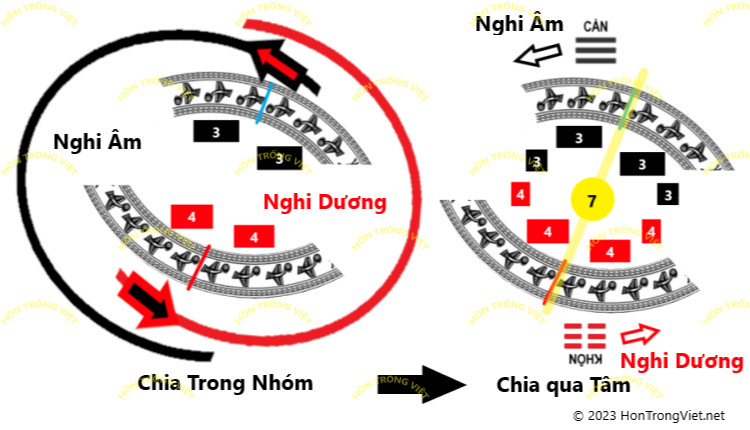
Above & below of Ring 8 there are 2 groups of chickens or storks moving in the Counterclockwise direction, the upper group has 6 & the lower group has 8 chickens.
Divided in half in each group, there will be numbers 3, 3, 4 & 4, corresponding to 4 trigrams – Yin, Yin, Yang & Yang in the direction of the moving chicken or in the CCW direction, and the numbers 4, 4, 3 & 3 or Yang, Yang & Yin, Yin. The order of those 2 sequences of numbers/trigrams is the instruction for each Yin and Yang part of the BQLD Bát Quái Lạc đồ giống TTBQ của KD nhưng phối với số Lạc Đồ còn TTBQ phối Hà Đồ. BQLD is similar to TTBQ or... More.
Bát Quái Lạc đồ giống TTBQ của KD nhưng phối với số Lạc Đồ còn TTBQ phối Hà Đồ. BQLD is similar to TTBQ or... More.
Next, draw a line through the center of the Drum to divide the drum into 2 parts. This central axis line simultaneously divides 2 chicken groups into two parts, yin and yang. Moreover, the axis line also indicates the starting position of each trigram in each part & the Law of Symmetry – 2 trigrams across the center are opposite in the Am Duong DTV coi quái Càn, Tinh thần, vô hình, vô hạn, vạch liền, số lượng lẻ, vòng tròn & màu đen là âm, còn quái Khôn,... More (Yin Yang
DTV coi quái Càn, Tinh thần, vô hình, vô hạn, vạch liền, số lượng lẻ, vòng tròn & màu đen là âm, còn quái Khôn,... More (Yin Yang DTV coi quái Càn, Tinh thần, vô hình, vô hạn, vạch liền, số lượng lẻ, vòng tròn & màu đen là âm, còn quái Khôn,... More) & their total energy level
DTV coi quái Càn, Tinh thần, vô hình, vô hạn, vạch liền, số lượng lẻ, vòng tròn & màu đen là âm, còn quái Khôn,... More) & their total energy level Biểu thị năng lượng của quái bằng số thập phân, thông qua số nhị phân. Represents the energy of the trigram in decimal, through the binary number.... More is 7.
Biểu thị năng lượng của quái bằng số thập phân, thông qua số nhị phân. Represents the energy of the trigram in decimal, through the binary number.... More is 7.
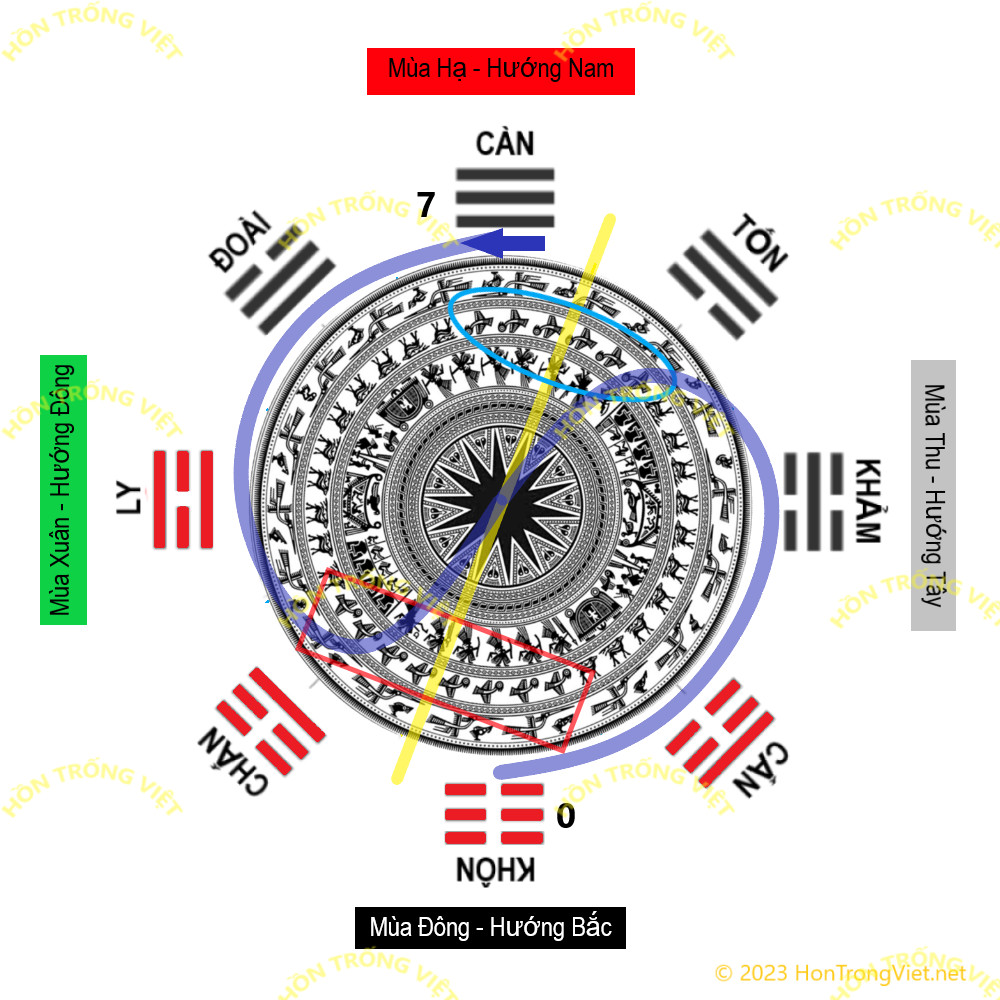
Can (Qian, ☰) is the most important & also the Yin trigram, so it will be the first of the Yin section. According to the instructions of the formula 68, the remaining trigrams will be positioned as shown in Figure 8. The found Bagua is called the Bat Quai Lac Do Là một Ma phương cân bằng mọi hướng như Lạc thư của KD nhưng với Dãy số 2, 7, 6 nằm bên trái và phối với... More. The BQLD’s trigrams are positioned in the same way as I Ching’s Early heaven eight trigrams
Là một Ma phương cân bằng mọi hướng như Lạc thư của KD nhưng với Dãy số 2, 7, 6 nằm bên trái và phối với... More. The BQLD’s trigrams are positioned in the same way as I Ching’s Early heaven eight trigrams TTBQ là Bát Quái của Kinh Dịch. TTBQ giống BQLD về vị trí các Quái, tuy nhiên, nó phối với Hà Đồ của KD, còn... More.
TTBQ là Bát Quái của Kinh Dịch. TTBQ giống BQLD về vị trí các Quái, tuy nhiên, nó phối với Hà Đồ của KD, còn... More.
Finding out BQLD Bát Quái Lạc đồ giống TTBQ của KD nhưng phối với số Lạc Đồ còn TTBQ phối Hà Đồ. BQLD is similar to TTBQ or... More also helps determine the time, direction & season on the Drum based on the Trigram’s energy level
Bát Quái Lạc đồ giống TTBQ của KD nhưng phối với số Lạc Đồ còn TTBQ phối Hà Đồ. BQLD is similar to TTBQ or... More also helps determine the time, direction & season on the Drum based on the Trigram’s energy level Biểu thị năng lượng của quái bằng số thập phân, thông qua số nhị phân. Represents the energy of the trigram in decimal, through the binary number.... More & common knowledge. For example, the hottest noon, Summer & South correspond to the highest energy Can (☰) & vice versa, the evening, winter & north direction correspond to the trigram Khon (☷).
Biểu thị năng lượng của quái bằng số thập phân, thông qua số nhị phân. Represents the energy of the trigram in decimal, through the binary number.... More & common knowledge. For example, the hottest noon, Summer & South correspond to the highest energy Can (☰) & vice versa, the evening, winter & north direction correspond to the trigram Khon (☷).
Based on the above information, we’ll also be able to find the 4 statues by removing the top line from the trigrams as shown in the Figure 9.

Space-time Coordinate
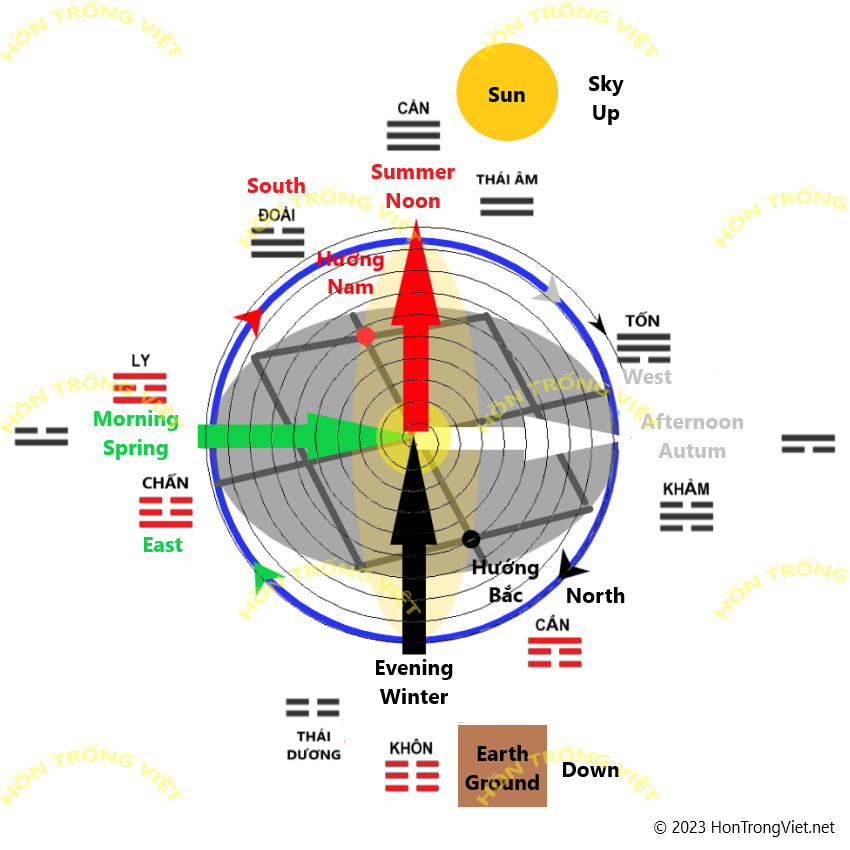
One of the meanings of the BQLD Bát Quái Lạc đồ giống TTBQ của KD nhưng phối với số Lạc Đồ còn TTBQ phối Hà Đồ. BQLD is similar to TTBQ or... More and the Four Statues is a space-time coordinate viewed from the northern hemisphere, and at more detailed level, possibly a map of the ancient Vietnam.
Bát Quái Lạc đồ giống TTBQ của KD nhưng phối với số Lạc Đồ còn TTBQ phối Hà Đồ. BQLD is similar to TTBQ or... More and the Four Statues is a space-time coordinate viewed from the northern hemisphere, and at more detailed level, possibly a map of the ancient Vietnam.
Opposite from the current maps, VDC has always placed the South direction upwards. This expression shows Drum’s creativity, human focus and wisdom. Understanding the philosophy behind this arrangement is enough to affirm that VDC or Viet’s book of changes did not originate from the divination.
The proverb “The head carries the heaven/sky, the foot tramples the earth” or the verse “Carries heaven tramples the earth lives in the world, the surname Tu, name Hai, originally from the Viet Dong …” in The Story of Kieu by the great poet Nguyen Du (1766 – 1820) expresses a person who is talented, strong, steady …, equal to, being the harmonious link between heaven & earth, spirit & matter, time & space, Am & Duong, infinite & limited etc. That image is of the human’s great Self, a Human part or interaction of the “Tam Tai” concept – Thien Dia Nhan or Heaven Earth Human that occupies the center in the Fig. 10.
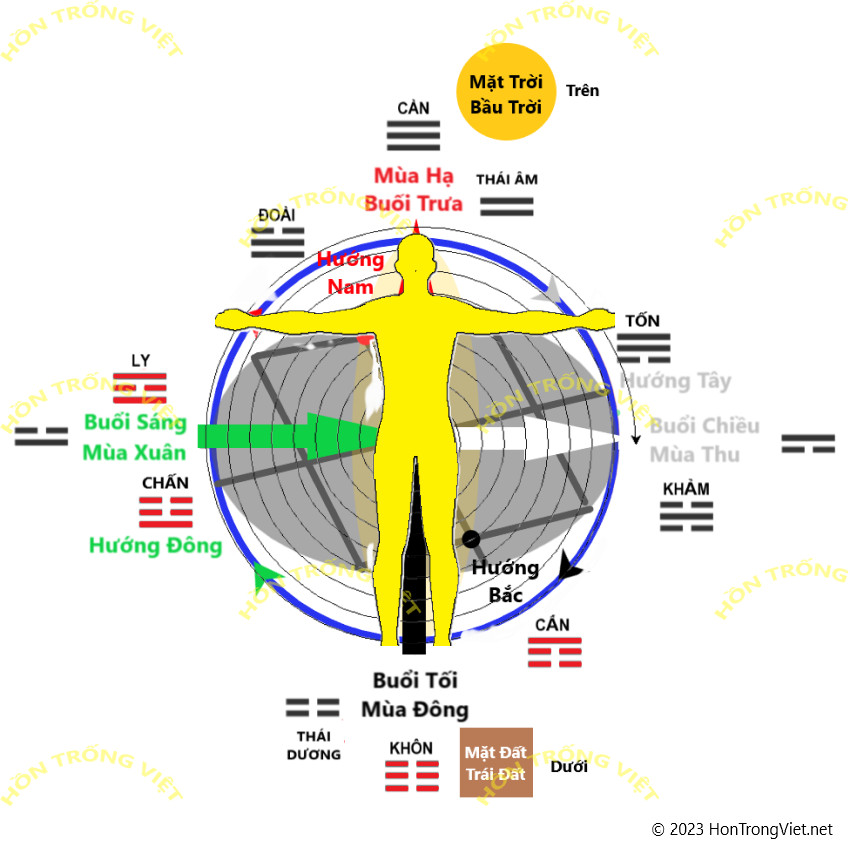
Placing the sun/sky on top also reflects the real experience of people, who always see the vast sky above, the sun on the top at noon & its disappearance in the evening. In terms of science, VDC already knew that the earth revolves around the sun, but here it places human in the center to express a lofty philosophy in a way that everyone can understand. Hiding the wisdom in the daily life indeed is the pinnacle of the Philosophy.
In addition, the metaphysical Sun or Càn, a symbol of the Spirit, which is high, light, and soaring that rightly occupies the highest & up position. By using the BQLD Bát Quái Lạc đồ giống TTBQ của KD nhưng phối với số Lạc Đồ còn TTBQ phối Hà Đồ. BQLD is similar to TTBQ or... More to express a person (discussed in other articles) shows a figure with a Spirit on the Top, Mind-Heart in the middle and Body or Matter at the bottom.
Bát Quái Lạc đồ giống TTBQ của KD nhưng phối với số Lạc Đồ còn TTBQ phối Hà Đồ. BQLD is similar to TTBQ or... More to express a person (discussed in other articles) shows a figure with a Spirit on the Top, Mind-Heart in the middle and Body or Matter at the bottom.
Am Duong Formula, Law of Symmetry & S shaped motion.
Besides formula 34 & the law of Symmetry mentioned above, connecting 8 trigrams from high to low energy level Biểu thị năng lượng của quái bằng số thập phân, thông qua số nhị phân. Represents the energy of the trigram in decimal, through the binary number.... More or vise versa, we’ll discover another important law – The Law of the S-shaped or spiral movement.
Biểu thị năng lượng của quái bằng số thập phân, thông qua số nhị phân. Represents the energy of the trigram in decimal, through the binary number.... More or vise versa, we’ll discover another important law – The Law of the S-shaped or spiral movement.
When it comes to Formulas, people will relate to Math & Sciences. Yet, VDC, a book on the Philosophy of Changes, spirituality & Yin Yang DTV coi quái Càn, Tinh thần, vô hình, vô hạn, vạch liền, số lượng lẻ, vòng tròn & màu đen là âm, còn quái Khôn,... More Five Interactions (ADNH) contains formulas. Especially, they are not merely simple additions, subtractions, multiplications, divisions, but represent the great fundamental laws of the Universe, Society & Man. Specifically, the following laws have been found through Formula 34:
DTV coi quái Càn, Tinh thần, vô hình, vô hạn, vạch liền, số lượng lẻ, vòng tròn & màu đen là âm, còn quái Khôn,... More Five Interactions (ADNH) contains formulas. Especially, they are not merely simple additions, subtractions, multiplications, divisions, but represent the great fundamental laws of the Universe, Society & Man. Specifically, the following laws have been found through Formula 34:
VDC’s 2 fundamental laws:
- The Law of Spiral motion: Energy moves spirally or with the S shape.
- The Law of Symmetry: 2 trigrams across the center are opposite in the Am Duong
 DTV coi quái Càn, Tinh thần, vô hình, vô hạn, vạch liền, số lượng lẻ, vòng tròn & màu đen là âm, còn quái Khôn,... More (Yin Yang
DTV coi quái Càn, Tinh thần, vô hình, vô hạn, vạch liền, số lượng lẻ, vòng tròn & màu đen là âm, còn quái Khôn,... More (Yin Yang DTV coi quái Càn, Tinh thần, vô hình, vô hạn, vạch liền, số lượng lẻ, vòng tròn & màu đen là âm, còn quái Khôn,... More) & their total energy level
DTV coi quái Càn, Tinh thần, vô hình, vô hạn, vạch liền, số lượng lẻ, vòng tròn & màu đen là âm, còn quái Khôn,... More) & their total energy level Biểu thị năng lượng của quái bằng số thập phân, thông qua số nhị phân. Represents the energy of the trigram in decimal, through the binary number.... More is 7.
Biểu thị năng lượng của quái bằng số thập phân, thông qua số nhị phân. Represents the energy of the trigram in decimal, through the binary number.... More is 7.